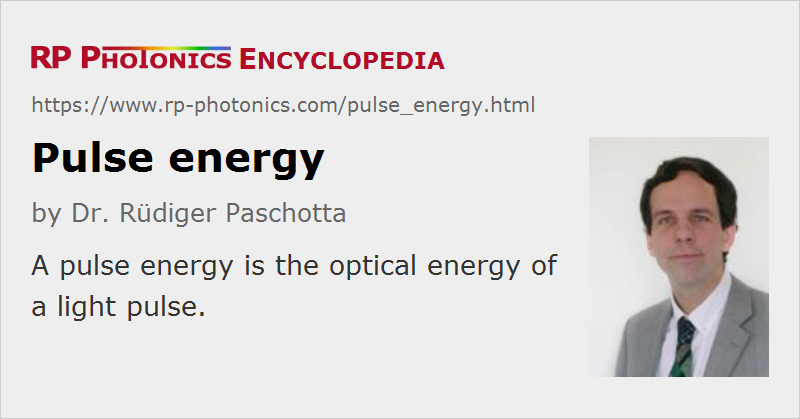Pulse Energy
Definition: energy of an optical pulse
German: Pulsenergie
Categories: light detection and characterization, optical metrology, light pulses
Formula symbol: Ep
Units: J
How to cite the article; suggest additional literature
Author: Dr. Rüdiger Paschotta
The pulse energy Ep is simply the total optical energy content of a pulse, i.e., the integral of its optical power over time.
For pulses with not too high pulse repetition rate, e.g. from a Q-switched laser, the pulse energy may be measured e.g. with a pyroelectric detector.
For regular pulse trains, the pulse energy is often calculated by dividing the average power (measured e.g. with a power meter) by the pulse repetition rate. However, this is a valid procedure only if the energy emitted between the pulses is negligible. There are cases where, e.g., a mode-locked laser emits a pulse train together with a low-level background emission. Even if the background power level is far below the peak power, the background can significantly contribute to the average power. If, e.g., a photodetector has an insufficient dynamic range for testing this, it can be useful to test the conversion efficiency of a frequency doubler in a carefully controlled situation in the low-conversion regime.
The pulse energy together with the pulse duration is often used to estimate the peak power of pulses. Conversely, temporal integration of the optical power results in the pulse energy.
Typical pulse energies from Q-switched lasers range from microjoules to millijoules, and for large systems to multiple joules or even kilojoules. Mode-locked lasers achieve much lower pulse energies (picojoules, nanojoules or sometimes several microjoules) due to their high pulse repetition rates and sometimes due to limiting nonlinear effects in the laser resonator. Much higher energies of ultrashort pulses can be achieved by amplifying pulses at a lower repetition rate, as obtained e.g. with a pulse picker or a regenerative amplifier.
Questions and Comments from Users
Here you can submit questions and comments. As far as they get accepted by the author, they will appear above this paragraph together with the author’s answer. The author will decide on acceptance based on certain criteria. Essentially, the issue must be of sufficiently broad interest.
Please do not enter personal data here; we would otherwise delete it soon. (See also our privacy declaration.) If you wish to receive personal feedback or consultancy from the author, please contact him e.g. via e-mail.
By submitting the information, you give your consent to the potential publication of your inputs on our website according to our rules. (If you later retract your consent, we will delete those inputs.) As your inputs are first reviewed by the author, they may be published with some delay.
See also: pulses, pulse characterization, optical energy meters
and other articles in the categories light detection and characterization, optical metrology, light pulses
 |



If you like this page, please share the link with your friends and colleagues, e.g. via social media:
These sharing buttons are implemented in a privacy-friendly way!